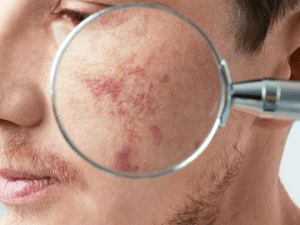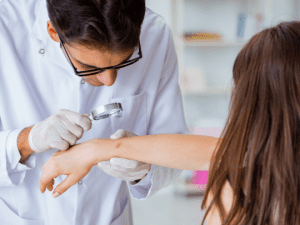What is Actinic Keratosis?
Actinic Keratosis (AK), also known as solar keratosis, is a rough, scaly patch on the skin caused by prolonged exposure to ultraviolet (UV) radiation. AK is considered a precancerous condition, as it can potentially develop into squamous cell carcinoma (SCC), a type of skin cancer, if left untreated.
Why is Actinic Keratosis So Common in Australia?
Australia’s high prevalence of AK is influenced by:
- Intense UV Radiation: The country’s high UV index increases the risk of sun damage.
- Outdoor Lifestyle: Many Australians spend a lot of time outdoors for work and recreation.
- Fair Skin Types: Lighter skin tones are more prone to UV damage.
What Causes Actinic Keratosis?
The primary cause of AK is cumulative sun exposure, leading to DNA damage in skin cells over time.
Risk Factors Include:
- Frequent and prolonged sun exposure, especially without sun protection
- Fair skin, light hair, and light-colored eyes
- Older age, as sun damage accumulates over years
- History of sunburns, particularly during childhood
- Outdoor occupations, such as farming, construction, or gardening
- Weakened immune system, including organ transplant recipients
- Use of tanning beds
What Does Actinic Keratosis Look Like?
Actinic Keratosis often appears as:
- Rough, scaly, or crusty patches on the skin
- Pink, red, or brown spots, often with a sandpaper-like texture
- Flat or slightly raised lesions, sometimes with a hard, wart-like surface
- Itchy, prickly, or tender areas on sun-exposed skin
Common Sites:
- Face, ears, scalp, and neck
- Forearms and hands
- Lower legs, particularly in women
How is Actinic Keratosis Diagnosed?
Actinic keratosis may be diagnosed through:
- Visual Examination: Using a dermatoscope to inspect the skin closely.
- Skin Biopsy: In some cases, a small skin sample may be taken to rule out squamous cell carcinoma (SCC) or other skin conditions.
Treatment Options for Actinic Keratosis
Early treatment is important to prevent AK from turning into SCC. Treatment options include:
- Topical Medications
- 5-Fluorouracil (5-FU): A cream that destroys sun-damaged skin cells.
- Imiquimod Cream: Boosts the immune response to eliminate abnormal cells.
- Diclofenac Gel: An anti-inflammatory treatment for mild AKs.
- In clinic Procedures
- Cryotherapy: Freezing the lesion with liquid nitrogen, causing the abnormal cells to peel away.
- Curettage and Electrosurgery: Scraping off the lesion followed by heat treatment to destroy remaining cells.
- Photodynamic Therapy (PDT): Applying a light-sensitive cream and exposing the area to a special light to destroy the cells.
What is the Prognosis for Actinic Keratosis?
Actinic Keratosis can usually be managed effectively with early treatment. However, some reports show around 10-15% of untreated AKs may progress to squamous cell carcinoma. Regular skin checks and ongoing sun protection are important to manage the risk.
How Can You Prevent Actinic Keratosis?
Follow the Slip, Slop, Slap, Seek, Slide advice:
- Slip on sun-protective clothing.
- Slop on SPF 30+ broad-spectrum sunscreen.
- Slap on a wide-brimmed hat.
- Seek shade, especially during peak UV hours.
- Slide on sunglasses with UV protection.
Other tips include:
- Avoiding tanning beds.
- Regular skin checks at home and with a healthcare provider.
- Treating early signs of sun damage before they become problematic.
When Should You See a Doctor?
You should consult a healthcare professional if you notice:
- New or changing scaly patches on sun-exposed skin
- Sores that don’t heal
- Lesions that bleed, itch, or feel tender
Early intervention can prevent potential progression to skin cancer.
Key Takeaway
Actinic Keratosis is a common and manageable condition, particularly with early detection and treatment. By practicing sun safety, conducting regular skin checks, and seeing a doctor for any suspicious skin changes, you can significantly reduce your risk of progression to skin cancer.





